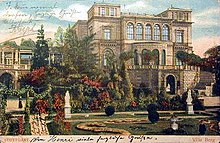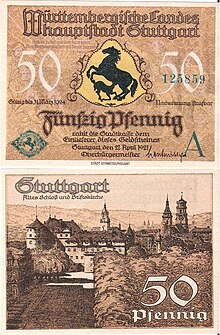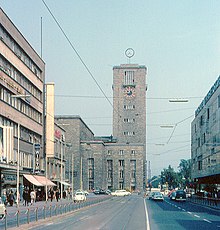History
Main article: History of Stuttgart
See also: Timeline of Stuttgart
Historical affiliations
Stuttgart's first Coat of Arms (1286)[c]
1634 Drawing of Stuttgart by Matthäus Merian
Drawing of Stuttgart, 1794.
Map of Stuttgart, 1888
Map of Stuttgart area, 1888
View of Stuttgart from Alexanderstraße, 1895. The Rotebühlkaserne is visible to the left, and the Old Castle and Stiftskirche to the right.
The historic Stuttgart Marktplatz looking west, 1881.
Stuttgart Rathaus on the Marktplatz, 1907. The building was destroyed by Allied bombing during World War Two. What was left of the building was used to build the current City Hall.
Villa Berg, the summer residence of the royalty of Wurttemberg built from 1845–1853, in a colorized photograph from 1910.
A colorized photo from 1911 of the Daimler-Motoren-Gesellschaft factory in Untertürkheim. Today, this building is the seat of Daimler AG.
Map of the destruction of Stuttgart after the air raids.
Stuttgart's Hauptbahnhof from the Königstraße, 1965.
Antiquity
Originally, the most important location in the Neckar river valley as the hilly rim of the Stuttgart basin at what is today Bad Cannstatt.[29] Thus, the first settlement of Stuttgart was a massive Roman Castra stativa (Cannstatt Castrum)[28] built c. 90 AD to protect the Villas and vineyards blanketing the landscape and the road from Mogontiacum (Mainz) to Augusta Vindelicorum (Augsburg). As with many military installations, a settlement sprang up nearby and remained there even after the Limes moved further east. When they did, the town was left in the capable hands of a local brickworks that produced sophisticated architectural ceramics and pottery.[30] When the Romans were driven back past the Rhine and Danube rivers in the 3rd Century by the Alamanni,[31] the settlement temporarily vanished from history until the 7th Century.[32]Middle Ages
See also: Germany in the Middle Ages
In 700, Duke Gotfrid mentions a "Chan Stada" in a document regarding property.[33] Archaeological evidence shows that later Merovingian era Frankish farmers continued to till the same land the Romans did.[34]Cannstatt is mentioned in the Abbey of St. Gall's archives as "Canstat ad Neccarum" (German: Cannstatt-on-Neckar) in 708.[citation needed] The etymology of the name "Cannstatt" is not clear, but as the site is mentioned as condistat in the Annals of Metz (9th Century),[citation needed] it is mostly derived from the Latin word condita ("foundation"), suggesting that the name of the Roman settlement might have had the prefix "Condi-." Alternatively, Sommer (1992) suggested that the Roman site corresponds to the Civitas Aurelia G attested to in an inscription found near Öhringen.[35] There have also been attempts at a derivation from a Gaulish *kondâti- "confluence".[32][36]
In 950 AD, Duke Liudolf of Swabia, son of the current Holy Roman Emperor Otto I, decided to establish a stud farm for his cavalry during the Hungarian invasions of Europe on a widened area of the Nesenbach river valley 5 kilometres (3.1 mi) south of the old Roman castrum.[29] The land and title of Duke of Swabia remained in Liudolf's hands until his rebellion was quashed by his father four years later. In 1089, Bruno of Calw built the precursor building to the Old Castle.[33]
Stuttgart's viticulture, first documented in the Holy Roman Empire in the year 1108 AD,[33] kept people in the area of that stud farm for some time, but the area was still largely overshadowed by nearby Cannstatt because of its role as a local crossroad for many major European trade routes.[37] Nevertheless, the existence of a settlement here (despite the terrain being more suited for that original stud farm) during the High Middle Ages is provided by a gift registry from Hirsau Abbey dated to around 1160 that mentions a "Hugo de Stuokarten."[33] A settlement at this locale was again mentioned in 1229, but this time by Pope Gregory IX.[26] In 1219 AD, Stuttgart (then Stuotgarten) became a possession of Herman V, Margrave of Baden.[26] In addition to Backnang, Pforzheim, and Besigheim, Hermann would also found the Stuttgart we know today in c. 1220.[38] In 1251, the city passed to the Ulrich I von Württemberg as part of Mechthild von Baden's dowry. His son, Eberhard I "the Illustrious,"[26] would be the first to begin the many major expansions of Stuttgart under the House of Württemberg.
Eberhard desired to expand the realm his father had built through military action with the aid of the anti-king Henry Raspe IV, Landgrave of Thuringia, but was thwarted by the action of Emperor Rudolph I. Further resistance by Eberhard I against the Emperor's created Vogts and Bailiwicks as well as the newly appointed Duke of Swabia Rudolf II, Duke of Austria eventually led to armed conflict and initial successes upon Emperor Rudolph I's death in 1291 against the Emperor's men. After initially defeating his regional rivals, Henry VII, newly elected as Emperor, decided to take action against Eberhard I in 1311 during his war with the Free imperial city of Esslingen by ordering his Vogt, Konrad IV von Weinberg, to declare war on Eberhard I. Eberhard I, defeated on the battlefield, lost Stuttgart and his castle (razed in 1311)[39] to Esslingen and the city was thus managed by the city state from 1312–15.[26] Total destruction of the County was prevented by Henry VII's death in 24 August 1313 and the elections of Louis IV as King of the Germans and Frederick III as anti-king. Eberhard seized the opportunity granted to him by the political chaos, and recaptured his hometown and birthplace in 1316,[40] and made much territorial gain. With peace restored at last, Eberhard began repairs and expansion to Stuttgart beginning with the reconstruction of Wirtemberg Castle, ancestral home to the House of Württemberg, in 1317 and then began expansion of the city's defenses. The early 1320s were an important one for Stuttgart: Eberhard I moved the seat of the County to the city to a new and expanded castle,[41] the collegiate church in Beutelsbach, where previous members of the Württemberg dynasty had been buried prior to its destruction in 1311,[40] moved to its current location in Stuttgart in 1320,[40] and the town's Stiftkirche was expanded into an abbey, and the control of the Martinskirche by the Bishopric of Constance was broken by Papal order in 1321.[40] A year after the city became the principal seat of the Counts of Württemberg in 1320,[28] the city was granted status as a city and given civic rights.[28] At the end of the 14th Century, new suburbs sprang up around Leonhard Church and near the city's fortifications as well. Towards the end of the 15th Century, Count Ulrich V began construction of a new suburb on the northeastern edge of the city around the Dominican monastery Hospitalkirche. In the 1457, the first Landtag of the Estates of Württemberg was established in Stuttgart and a similar institution was established in Leonberg. After the temporary partitions of the County of Württemberg by the Treaties of Nürtingen, Münsingen, and Esslingen, Stuttgart was once again declared the capital of the County in 1483.[40]















No comments:
Post a Comment